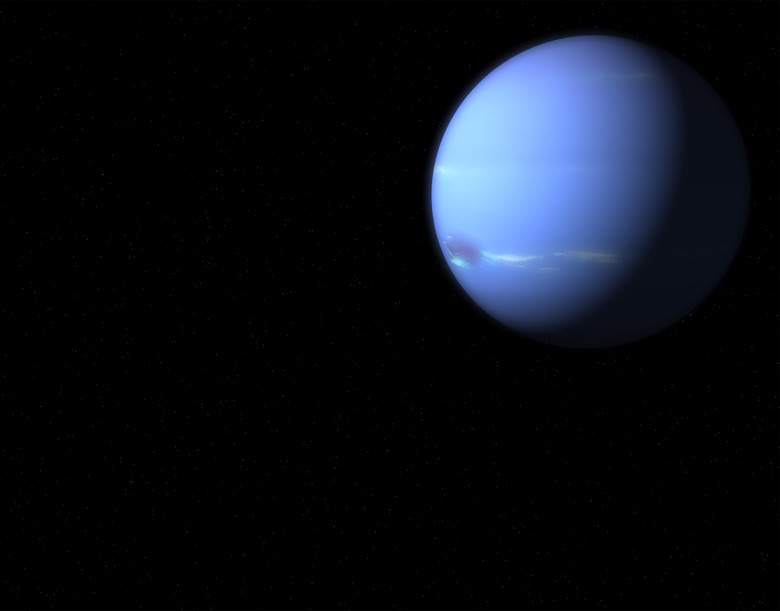Internal Structure Of Neptune
The solar system's most distant planet, Neptune is really one large, stormy atmosphere composed mostly of ices surrounding a rocky core. Astronomers classify it as both a gas giant and an ice giant. Although it rotates around its own axis in 16 Earth hours, Neptune takes 165 Earth years to complete one orbit around the sun.
Atmospheric Composition
There is no identifiable surface on Neptune, as is the case on Earth, Mars and other terrestrial planets. The atmosphere, composed mostly of hydrogen and helium with trace amounts of methane and ammonia, increases in density toward the planet's interior. Dark belts of unknown composition and large white methane clouds are present in the upper atmosphere. Wind speeds on Neptune can reach 2,100 kilometers per hour (1,312 miles per hour) and produce storm systems. The storms may be driven by an internal heat source as Neptune radiates 2.6 times the energy it absorbs from the sun. It has the same surface temperature of negative 214 degrees Celsius (negative 353 degrees Fahrenheit) as Uranus, which is closer to the sun and yet receives only 40 percent its solar radiation.
Slushy Mantle
Neptune's mantle may be composed of water, methane and ammonia ices that behave as a liquid under pressure and are able to conduct electricity. As the planet rotates, these liquids behave as a dynamo and generate a magnetic field. But Neptune's internal pressures may not be large enough to create the types of liquid metallic hydrogen mantles found on Saturn and Jupiter.
Rocky Core
Astronomers believe that Neptune's core could be Earth-sized and composed of rock together with ammonia, methane and water ices. The pressure at the core may be sufficient for these compounds to disassociate into separate oxygen, carbon in the form of diamond, helium, nitrogen and hydrogen elements. Hydrogen and diamond release energy as they sink and rise within the core and could generate the planet's internal heat source.
Moons and Rings
There are 13 confirmed moons orbiting around Neptune and a system of six main rings. Neptune's largest moon is Triton. It could have been an icy body from beyond Neptune's orbit — a Kuiper Belt object — that was captured by the planet's gravitational field. It has a thin nitrogen atmosphere and clouds of condensed nitrogen. Ice volcanoes on its surface erupt mixtures of methane, liquid nitrogen and dust.
Cite This Article
MLA
Kielmas, Maria. "Internal Structure Of Neptune" sciencing.com, https://www.sciencing.com/internal-structure-neptune-21304/. 24 April 2017.
APA
Kielmas, Maria. (2017, April 24). Internal Structure Of Neptune. sciencing.com. Retrieved from https://www.sciencing.com/internal-structure-neptune-21304/
Chicago
Kielmas, Maria. Internal Structure Of Neptune last modified March 24, 2022. https://www.sciencing.com/internal-structure-neptune-21304/
